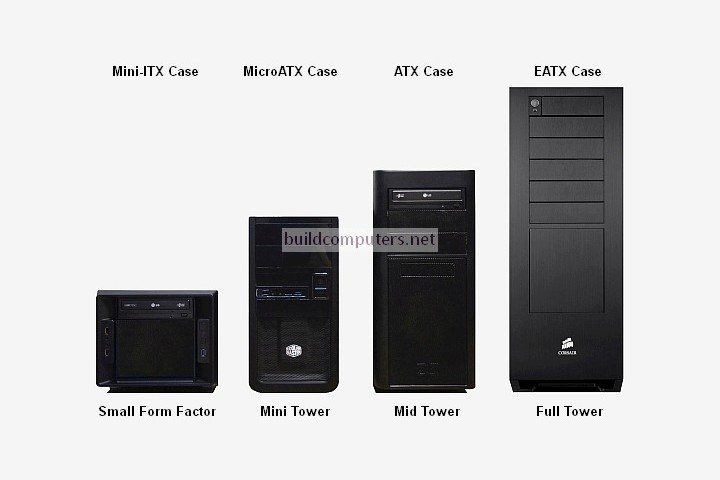Desktop Computer Case Sizes
What is the difference between computer case sizes and which one will suit you best? Learn the answer here as we compare the different types of desktop computer cases.
We can't speak for other things, but size matters a lot for a desktop computer case.
One, it determines the type and number of components that will fit inside your computer - For more details, see our Computer Case Size Comparison below.
Two, it affects the cooling and ventilation within the case. A bigger case tends to have superior cooling - It contains more air to dissipate heat plus it is able to accommodate more fans, larger coolers and taller heat sinks.
Most computer cases come in four distinct sizes: small form factor (SFF), mini tower, mid tower and full tower. The image below shows the distinct difference between PC case sizes:
Computer Case Size Comparison
Unlike motherboard form factors, there aren't standardized
specifications for computer cases. That said, our computer case size chart below will apply to the vast majority of PC casings:
|
SFF |
Mini Tower |
Mid Tower |
Full Tower | |
|
Motherboards |
Mini-ITX |
Mini-ITX |
Mini-ITX |
Mini-ITX |
|
5.25" Drive Bays |
1 |
1 to 2 |
2 to 5 |
3 to 6 |
|
3.5" Drive Bays |
1 to 3 |
4 to 6 |
6 to 8 |
6 to 13 |
|
2.5" Drive Bays |
0 to 4 |
0 to 4 |
0 to 10 |
0 to 11 |
|
Expansion Slots |
2 |
4 |
7 to 8 |
7 to 10 |
|
Graphics Cards |
1 |
1 to 2 |
2 to 3 |
3 to 4 |
|
Case Fans |
1 to 3 |
2 to 4 |
3 to 9 |
5 to 10 |
5.25" Drive Bays - For optical drives (e.g. DVD and Blu-ray drives), multi card readers, fan controllers, cooling fans and even drawers. Most 5.25" bays are external.
3.5" Drive Bays (Internal) - For desktop hard disk drives
3.5" Drive Bays (External) - For multi card readers, USB ports hub and cooling fans
2.5" Drive Bays - For solid state drives and laptop hard disk drives. Most 2.5" bays are internal. Some low end and older cases lack 2.5" bays, but you can always install SSDs into 3.5" bays using converter brackets.
Expansion Slots - For expansion cards such as graphics cards, sound cards, network cards (Wi-Fi, Ethernet, Bluetooth) and connector cards (USB, FireWire, eSATA). Mid to high end graphics cards often take up two slots.
1. Small Form Factor (Mini-ITX Case)
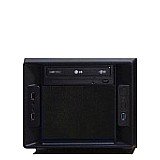
Once cast aside as niche cases with limited uses, small form factor
casings have been gaining rapid popularity in recent years. Why this
newfound love for the smallest computer case size? Let's find out...
Home Theater PC - A small form factor case is perfect for housing a HTPC. Their small size makes them a great fit for most TV shelves and closets, plus they won't look out of place next to other home theater equipment. And since HTPCs don't demand much computing power, you'll be able to squeeze the required hardware into a nice little case.
Space-Saving - A Mini-ITX case also makes a lot of
sense for basic users with limited space. Whether you're working in a
small office or living in a cramped apartment, a SFF case will save you a
lot of space... while being much easier and cheaper than laptop to
repair and upgrade.
Semi-Portable - While a shoebox case isn't going to fit into a traveling pouch, it is still light enough to be carried around. A typical small form factor PC weighs around 4 to 7 kg (when fully loaded), making it an appealing choice for people who need to move often and gamers who attend LAN parties.
SEE ALSO: Recommended Mini ITX Cases
2. Mini Tower (MicroATX Case)
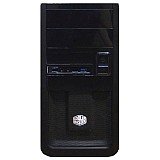
With more and more people turning to smaller cases, mini towers have been gradually replacing mid towers as the most common case size for average consumers. This growing preference for MicroATX cases isn't surprising when you consider the following:
Budget PC - All things equal, mini towers tend to be the cheapest among the different computer case sizes (simpler design and less materials needed). Mini towers also support MicroATX motherboards, which happen to be the most common form factor for budget boards.
And the savings do not stop there - Despite their size, most mini towers are still able to accept (cheaper) standard sized components. On the other hand, SFF cases sometimes require smaller and more expensive parts such as SFX power supplies and low profile graphics cards.
Flexible Placement - Not too big, not too small... A mini tower's Godilocks size allows it to be stashed almost anywhere - It works just as well sitting on your
desktop or floor. Compare this to a shoebox case which is too short for
the floor... or a full tower that is massive enough to devour most table tops.
3. Mid Tower (ATX Case)
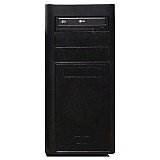
Once upon a time, mid towers were the standard computer case
size for most people regardless of usage. While its smaller siblings have eroded its market share over time, ATX cases remain popular to this day and there are good reasons for choosing one:
Gaming - Most mid to high end graphics cards take up two expansion slots each and can stretch up to ~31 cm (12.1 inches) long. Most mid towers are able to support two such cards, packing enough gaming muscle for at least 95% of gamers out there. Some gaming mid towers can even take up to three cards, though we do recommend a full tower for a triple GPU setup.
And it's not about just squeezing big graphics cards into a case. Graphic cards are the hottest components in a PC, hitting temperatures of up to 90°C under load. Toss in a 60 to 70°C CPU, and we end up with something capable of cooking eggs. A mid tower's roomier interior allows for better air circulation, plus gives you more space for additional case fans and larger heat sinks.
Cable Management - Power cables, data connectors, case wires... Left unchecked, the insides of a PC case can quickly degenerate into a rat's nest of wires. The extra drive bays, additional cable routing holes and bigger side panel clearance all add up to simpler and better cable management. This goes a long way in improving air flow and reducing dust buildup over time.
4. Full Tower (EATX Case)
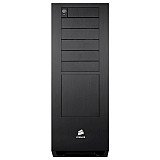
Full towers have always attracted a very dedicated following - server admins, PC enthusiasts, overclockers and hardcore gamers. Why do these power users show such unwavering devotion towards mega cases? Let's explore the reasons in detail...
Servers - In order to accommodate a second CPU and extra RAM slots, server motherboards can get quite massive. Most mid towers can't hold anything larger than a standard ATX motherboard, so you'll need a full tower to house the larger EATX and SSI CEB server boards.
Overclocking - Pushing the limits of your computer requires a lot of cooling, and proper cooling equipment can take up a lot of space. 230 mm case fans, dual tower heat sinks, triple radiators... only a full tower can contain these monsters with room to spare. What's more, larger computer case size = higher air volume = better ventilation and heat dissipation.
Hardcore Gaming - For some, playing the latest games with relative smoothness isn't enough - They demand 4K resolution gaming...with ultra settings...on a triple monitor setup. If that sounds like you, then you'll want a full tower capable of transforming into a gaming monster with triple or even quad graphics cards.

